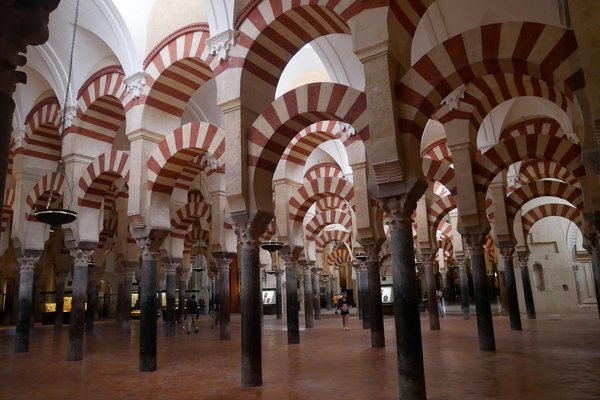Spain
Cordoba
The Historic Centre of Cordoba comprises its Mosque-Cathedral and surrounding quarters, a testimony to its blossoming during the Islamic Caliphate of Cordoba.
After 711 CE, Cordoba was turned into a powerful Islamic city that was meant to rival the splendors of Constantinople, Damascus and Baghdad. Mosques, palaces and public buildings were erected. After the Siege of Córdoba in 1236, which was won by the forces of the Christian King of Castile, the Great Mosque was turned into a cathedral and new defensive structures were erected. The Mosque’s design remained influential on Western Islamic art and the 19th-century neo-Moorish style.
Community Perspective: In addition to the former Mosque and its forest of pillars, the Alcazar and its gardens and the Capilla Mudejar de San Bartolome are also amazing. The rest of the historic centre is deemed too overly touristy.
Site Info
Official Information
- Full Name
- Historic Centre of Cordoba (ID: 313)
- Country
- Spain
- Status
-
Inscribed 1984
Site history
History of Cordoba
- 1994: Extended
- "Historic Centre" rather than just the Mosque
- 1984: Inscribed
- Inscribed
- Type
- Cultural
- Criteria
- i
- ii
- iii
- iv
Links
- UNESCO
- whc.unesco.org
- Official
-
- turismodecordoba.org — Turismo de Cordoba
- Related
-
- cyberspain.com — Link
All Links
UNESCO.org
- whc.unesco.org — whc.unesco.org/
Official Website
- turismodecordoba.org — Turismo de Cordoba
Related Resources
- cyberspain.com — Link
News Article
- Aug. 9, 2025 theguardian.com — Firefighters save Córdoba’s historic mosque-turned-cathedral La Mezquita
- March 14, 2016 theguardian.com — Córdoba rejects Catholic church's claim to own mosque-cathedral
- Dec. 16, 2014 bnd.com — Spain church criticized over Cordoba monument name
Community Information
- Community Category
- Urban landscape: Urban continuity
Travel Information
Recent Connections
-
Asterix
In Astérix en Hispanie, they travel via…
-
Game of Thrones (Filming Locations)
Roman bridge of Córdoba – season 5See w…
-
Andalusia hotspot
Connections of Cordoba
- Individual People
-
-
Christopher Columbus
Received by Ferdinand and Isabella in the Alcazar -
Alexandre Dumas
In his work "Impressions de voyage – De Paris à Cadix", Dumas recounts his visits to Burgos, Madrid, the Escurial, Aranjuez, Toledo, Jaén, Granada, where he visits the Generalife and the Alhambra and Cordoba. In Seville, Dumas visits, among other places, the Alcazar and the Giralda. -
Charles V
"The most significant alteration was building a Renaissance cathedral nave in the middle of the structure. It was constructed by permission of Charles V"
-
- Geography
- Trivia
-
-
Former Largest Cities
From 920-1000 A.D. -
Cities of Three Cultures
Jewish, Christian, MoslimSee sevilla.abc.es
-
Twin Towns
With Medina Azahara -
Depicted in Mizielinska Maps
MezquitaSee i.pinimg.com
-
Moved from location of original construction
Mezquita has columns from Merida -
On Euro coins
Spanish 2010 commemorative 2 Euro
-
- History
-
-
Located in a Former Capital
Western Umayyad Caliphate of Cordoba (756-1031) -
The Inquisition
The Alcazar de los Reyes Cristianos was used as a forum and prison during the Inquisition. Part of it is called the Inquisition Tower -
History of Aviation
Abbas Ibn Firnas, known for an early attempt at aviationSee en.wikipedia.org
-
Umayyad Caliphate
Caliphate of Córdoba, a spin off from the original Umayyads of Damascus - built Great Mosque of CórdobaSee archnet.org
-
Almohads
In the 12th century, the Almohads transferred the capital of Muslim Iberia from Córdoba to Seville. During the struggle for succession that erupted in 1224, Abd Allah al-Bayyasi established himself in the city of Cordova, after capturing the city and raiding the region, in defiance of his cousin Abdallah al-Adil, who had declared himself Caliph. After al-Bayyasi had given some territory over to the Castilians for their help, a popular uprising broke out in Cordova and al-Bayyasi was killed. His head was dispatched to Marrakesh as a trophy. Cordova was eventually conquered by Castile in 1236. (wiki)See en.wikipedia.org
-
Ancient Roman colonies
Colonia Patricia -
Eunuchs
Young boys termed Slavs (Arabic Ṣaqāliba) in the Arabic texts were brought to Cordoba by the thousands to serve as palace eunuchs. "The most lucrative slave market was the Islamic slavery in Al-Andalus. The Arabic Caliphate of Córdoba referred to the forests of Central and Eastern Europe, which came to function as a slave source supply, as the Bilad as-Saqaliba ("land of the slaves")." (wiki)See en.wikipedia.org
-
- Architecture
-
-
Churrigueresque
stalls of the Cathedral Choir -
Baroque
Cathedral-Mosque: "The minaret has also been restyled into a Baroque bell tower.", also: Descalzas Convent, and other places in historic center. -
Spolia
Mosque–Cathedral of Córdoba: The building is most notable for its arcaded hypostyle hall, with 856 columns of jasper, onyx, marble, and granite. These were made from pieces of the Roman temple which had occupied the site previously, as well as other destroyed Roman buildings, such as the Mérida amphitheatre. (wiki) -
Hypostyle
The Mosque-Cathedral "is most notable for its arcaded hypostyle hall, with 856 columns of jasper, onyx, marble, and granite. These were made from pieces of the Roman temple which had occupied the site previously, as well as other destroyed Roman buildings, such as the Mérida amphitheatre. The double arches were a new introduction to architecture, permitting higher ceilings than would otherwise be possible with relatively low columns." SeeSee en.wikipedia.org
-
Mudejar style
Mudejar Chapel of San Bartolomé -
Muqarnas
Cúpula de mocárabes, Sala de los Abencerrajes -Mezquita de Córdoba.See www.pinterest.es
-
Moorish architecture
Great Mosque of Cordoba: "The Puerta de San Esteban (formerly the Bab al-Wuzara in Arabic) is one of the oldest well-preserved and historically significant gateways of Moorish architecture." and "It had a major influence on the subsequent architecture of Al-Andalus and of the Maghreb – what is known as "Moorish" architecture or western Islamic architecture – due to both its architectural innovations and its symbolic importance as the religious heart of the region's historic Cordoban Caliphate" (wiki)See en.wikipedia.org
-
Gold Surfaces
Gilded doors of Mezquita -
Romanesque
Several of the "Fernandine churches" -
Mosaic art
Numerous Roman mosaic floors have been found in the historic centre of Cordoba. Some of them are presented in the Mezquita and the Alcazar.See sevilla.abc.es
-
- World Heritage Process
-
-
Perfect Inscriptions
1984 -
First inscriptions
Spain: five inscriptions in 1984, with Historic Centre of Cordoba (then The Mosque of Cordoba) as the first recorded and with the lowest number -
Extended
1994: Historic Centre rather than just the Mosque
-
- Religion and Belief
-
-
Carmelites
St. Anna and St. JosephSee declausura.org
-
Cathedrals
Mezquita de Córdoba -
Notable mosques
Mezquita - 8th century - Sunni (former mosque, now a cathedral) -
Converted Mosques
Was a Visigoth church before being converted to a mosque in 784. Became a Church again in 1236. -
Jewish religion and culture
-
Cistercian
Monasterio de la EncarnaciónSee es.wikipedia.org
-
Dominican Order
Convent of the Crucified Jesus -
Franciscan Order
St. Francis church, St. Peter of AlcantraSee es.wikipedia.org
-
- Constructions
-
-
Notable Bridges
Roman Bridge, built in the early 1st century BCSee en.wikipedia.org
-
Historical Organs
Gospel organ at the cathedral from the 17th century, one of the largest in Spain -
Freestanding Bell Tower
MezquitaSee guias-viajar.com
-
Prison
The alcazar was used as a prison during the inquisition. -
Baths
"Banos arabes" Wiki - "Many tourists visit the Arab baths, which were actually built under Alfonso XI" -
Water wheels
Molino de la Albolafia -
Hospitals
Hospital del Cardenal Salazar -
Horse Stables
Cordoba Royal Stables (1572)
-
- WHS on Other Lists
-
-
UNESCO Intangible Cultural Heritage Lists
Fiesta of the patios in CordovaSee ich.unesco.org
-
The Jean-Paul-L’Allier Prize for Heritage
2015: The urban project and the cultural landscape: heritage, culture, trade and tourism – renovation of Cruz Conde street
-
- Timeline
-
-
Built in the 8th century
Mezquita built in 784-987
-
- WHS Hotspots
- Literature & Film
-
-
Game of Thrones (Filming Locations)
Roman bridge of Córdoba – season 5 -
Asterix
In Astérix en Hispanie, they travel via Coca, Segovia, Salamanca and Cordoba to Seville.
-
News
- theguardian.com 08/09/2025
- Firefighters save Córdoba’s histor…
- theguardian.com 03/14/2016
- Córdoba rejects Catholic church's …
- bnd.com 12/16/2014
- Spain church criticized over Cordo…
Recent Visitors
Visitors of Cordoba
- 2Flow2
- Adam Hancock
- Adolfo
- Adrian
- Adrian Turtschi
- Afshin Iranpour
- aj
- Alberto Rodriguez Gutierrez
- aleserre
- alex
- Alexander Barabanov
- Alexander Lehmann
- Alexander Parsons
- alicemears
- Alikander99
- Aljaz
- ALS
- Alvaro1404
- A. Mehmet Haksever
- Ammon Watkins
- Ana
- Ana Lozano
- Anna Wludarska
- Ansitong
- Antonio J.
- Argo
- ArnaudFilloux
- arnaugir
- Aspasia
- Assif
- Astraftis
- a.thum
- Atila Ege
- AustralLights
- awestix
- AYB
- Badwater
- Bamse
- BaziFettehenne
- beckyjo27
- Bill Maurmann
- Bin
- Birgitte Sørensen
- bossc
- butterflybird
- CampbellME
- Carlo Medina
- Caspar
- CeeMon
- cflw
- chenboada
- Chinmaya
- chiuliqi
- Chole Ross
- ChrisN
- Christian Wagner
- Christine
- Christoph
- Christravelblog
- Cirene Moraes
- Claire Bradshaw
- Clyde
- Col
- Coppi
- Corinne Vail
- Cristina Erba
- Csaba Nováczky
- CugelVance
- cwthong
- Cyberczar
- CynthiaSam
- czesioszpachelka
- Damientournay
- dana144
- Dani Cyr
- Daniela Hohmann
- Daniel Chazad
- Danieljbromberg
- dankir
- Danny L
- Dan Pettigrew
- dave wood
- David Berlanda
- David Marton
- Dimitar Krastev
- Dimitrios Polychronopoulos
- DL
- Dolemite92
- Don Irwin
- Dorejd
- Doubanjiang
- DouglasR
- Dr. Caligari
- Dwight Zehuan Xiao
- Echwel
- edstar500
- eej
- Elaine McArdle
- Elf21
- Elia Vettorato
- eljx1988
- Els Slots
- emvcaest
- erdsaumnaht
- Erfe91
- Eric Lurio
- Erik Jelinek
- Eva Kisgyorgy
- Evgenii
- Fam39
- Fan Yibo
- Farinelli
- Feldhase
- Femke Roos
- Fernweh
- Filip Murlak
- Frederik Dawson
- FS
- GabLabCebu
- Galgalula
- Garry Jackson
- Gary Arndt
- Geert Luiken
- George Gdanski
- GeorgeIng61
- Gilles
- giulio25
- grimloch
- Grzegorz Andruszkiewicz
- Hadrianus
- halryder
- Hammeel
- HaraldOest
- Harald T.
- Harry Mitsidis
- Hasco
- H Beswick
- hegeline@icloud.com
- henrik_hannfors
- Hubert
- Hughes1920
- Hunstow
- Iain Jackson
- Ian Cade
- ih0000
- Ilya Burlak
- irosey
- Ivan
- Ivan Rucek
- ivantham
- Jaakkotoivanen
- jacob76
- Jacob Otten
- Jakob F.
- Jana and Matt
- janameerman
- janem
- Janina Lehmann
- janis
- Janos
- Jarek Pokrzywnicki
- Jasam
- Javier
- Javier Coro
- Jean Lecaillon
- Jeanne OGrady
- Jens
- Jezza
- JJ10
- JL
- J_neveryes
- João Aender
- JobStopar
- Joel on the Road
- John Smaranda
- Jonas Hagung
- Jonas Kremer
- Jonas Martinsson
- jonathanfr
- Joyce van Soest
- JR's HERITAGE SITES
- Justin
- jxrocky
- KarenBMoore
- Karito Vies
- Kbecq
- Ken DJ
- KentishTownRocks
- Kerékgyártó
- Kevin247
- Kevin Padley-Knight
- kjluebke
- Klara Woodson
- Klaus Freisinger
- KngAlaric
- Krijn
- krtek
- Krzysztof B
- kutasp
- La Concy
- Laffingleigh
- Lameduck99
- Lara Adler
- Laurine
- LaVale
- Lazerway
- Liamps91
- Linz
- Lisu Marian
- Little Lauren Travels
- ljowers
- Loic Pedras
- Luboang
- Lucio
- Luis Filipe Gaspar
- Lukasz Palczewski
- lynnz317@aol.com
- Maciej Gil
- Maciej Gowin
- Malgorzata Kopczynska
- Małgosia Łupicka
- Manon R
- Manuelfunk
- MarcoB_0
- marc Rouserez
- Mariam
- Martin
- Martinacurra88
- Martina Rúčková
- Marton Kemeny
- maryhattie
- Mateusz
- Matthewsharris
- MAURO PODDA PANI
- Max
- MaYumin
- MH
- M. Huineman
- MichaelH
- Michael Novins
- michaelsballard
- Mihai Dascalu
- Mikan22
- Mikko
- Mikko Syrjä
- Milan Jirasek
- MMM
- Mo-han Je
- Monica Tasciotti
- MoPython
- Morodhi
- Msarmiento1979
- MWaters66
- Naim Y
- nan
- napalm
- natlefebvre@hotmail.
- Niall Sclater
- Nick M
- nico4gr
- Nihal Ege
- nikolamus
- Nolan B.
- Olli-Pekka Turunen
- Onkrad
- opperpco3
- PabloNorte
- Paola Laura
- Patrik
- Patrik_globe
- Paul Schofield
- Persian Globetrotter
- PeterH
- Peter Lööv
- Petteri
- pghgeekgrrl
- Philipp Leu
- Philipp Peterer
- phillipmeng
- pietprive06@kpnmail.nl
- Pink Bunny
- Porcho
- Potsdamer
- Pradip Tripathy
- pressdm
- Priyaranjan Mohapatra
- puessergio
- Purrfect
- Qin Xie
- Ralf Regele
- Ralf Rotheimer
- Randi Thomsen
- reddargon
- Reiseblitz
- Reisedachs
- Remigiusz
- Reza
- Rick Ohm
- RobRos
- Roel Sterken
- rogerding
- Roger Ourset
- Roman Bruehwiler
- Ronbon
- Rosemary
- Sabrina Liebehentschel
- Samy G
- sandersx2
- Sandmann15
- saraleonela
- Schnitzel
- Sclowitz
- scubarrie
- SDMArado
- Sergio Arjona
- Shandos Cleaver
- sibariam
- Sijia
- sime147
- Simonf
- Slavi
- Solivagant
- Sorel Americo
- Squire Sullen
- Ssong.x
- Stan
- Stanislaw Warwas
- Stijn
- streliorsi
- Sutul
- Svein Elias
- Szabolcs Mosonyi
- Szabo Viktoria
- Szucs Tamas
- Tamara Ratz
- Tammy Gouldstone
- Taotao Chen
- Tarquinio_Superbo
- Tcchang0825
- Ted Coombs
- Tevity
- Thomas Buechler
- Thomas Harold Watson
- Thomas van der Walt
- Thorben
- Tim Allen
- Timothy C Easton
- TimPick
- Tinamu
- Tinuszke
- Tom Flaten
- Tonisan
- tony0001
- Tony H.
- triath
- Truls Brekke
- Tsunami
- valentinaui
- Vanessa Buechler
- Van Hung
- Velvetlapis
- Veronica
- Viaje al Patrimonio
- Vincent Cheung
- V&M
- voyager
- Walter
- wantrain.
- Waters88
- WestcountryWanderer
- Westwards
- WILLIAM RICH
- Wimmy
- Wojciech Fedoruk
- Wo_ko
- wolfboy
- wrung24
- Xander Huang
- Xiong Wei
- Xiquinho Silva
- Yongcheng Liu
- Zach
- Zoë Sheng
- Zos M
- Zsuzsanna Forray
- ZZSong
- Александар Стојиљковић
Community Reviews
Show full reviews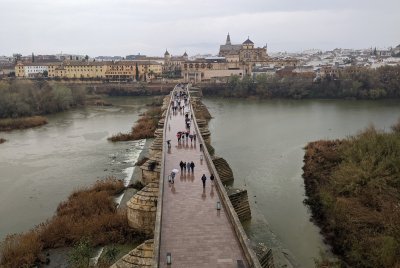
I did this as a joint-trip to Córdoba and Sevilla in March 2025 with my wife and a friend of ours, and while I wanted to like Córdoba more, I think Sevilla ultimately beat it out. (Perhaps to the chagrin of someone like Clyde here on the site.) However, Córdoba is still worth seeing!
Everyone raves about the Mezquita-Catedral ("Mosque-Cathedral") and they are right to – I recommend planning in a decent amount of time for yourself to spend here, at least two or three hours. There is so much to see on every wall, floor, or ceiling, it reminded me of the cathedral in Toldeo, Spain or St John's Co-Cathedral in Malta. However, the audio guide is slightly lacking, sadly, and the map they give you to accompany it is a bit confusing to try and navigate. All three of us got lost while wandering around the Mosque-Cathedral trying to follow its guide.
People talk about visiting the Calleja de las Flores ("Alley of Flowers") and all of the little winding streets around it that are chock-full of small shops and places to eat. I do recommend visiting this, and it blends into the Judería ("Jewish quarter"). The synagogue is worth visiting for ~15 minutes and it is one of four that exist in Spain.
It's worth buying the combined ticket to see the Alcázar de los Reyes Cristianos ("Alcazar of the Christian Kings"), the Baños del Alcázar Califal (the hammam baths of the Alcazar Calif), …
Keep reading 0 comments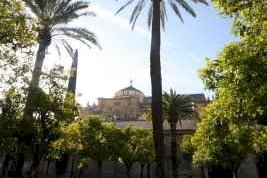
March 2017- 25 years before my parents took me to a conference in Cordoba, and I have the best memories of it. Now I wanted to do a revisit. We stayed in a small Hotel and strolled around the jewish city, juderia, for a whole day. It is just beautiful and its worth to sneek into every second courtyard to be overwhelmed by their beauty. We visited the alcazar, next to old town. And the next morning we finally got tickets to get into to Mezquita. One of europes highlight which is overwhelming. We spent nearly 1 hour in the building a shot numerous pictures from any perspective.
Cordoba and Granada made this trip perfect. We are wishing to come back someday.
Keep reading 0 comments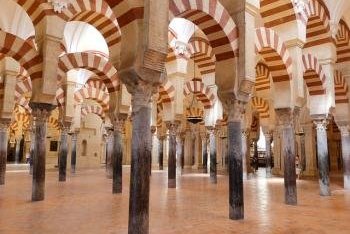
I visited this WHS in September 2017. Together with Granada (and most probably Seville), this WHS is not only Andalucia's highlight but perhaps Spain's if not Europe's. It has definitely earned its place on my personal top 100 WHS.
The iconic red and white arches of the Mezquita are so iconic (photo) and there are hundreds of them in the gigantic mosque-cathedral of Cordoba. But Cordoba is much more than that. The exterior of the huge Mezquita is as impressive as its interior. I particularly enjoyed the different puertas with their intricate red and white carvings and doors. Another gem is the 15th century Capilla Mudejar de San Bartolome, neatly hidden amidst the famous shaded patios with numerous pots and plants.
The view from the bridge and tower are worth taking in. Perhaps the best thing about Cordoba is that it has a natural buffer surrounding it which is the Sotos de la Albolafia Natural Park. There's a short trail which takes you from one mill to the next on the Guadalquivir river banks. The UNESCO WHS inscription plaque is just to the left of the bridge (if you cross the bridge facing the Mezquita). If you love gardens, then go for a short visit to the Alcazar de los Reyes Cristianos (closed on Mondays).
Even though the entrance to the Mezquita costs 8 euros, you can visit for free from 08:30 to 10:00 every day. After your visit to the Mezquita, make sure to pop in Casa Santos for …
Keep reading 0 comments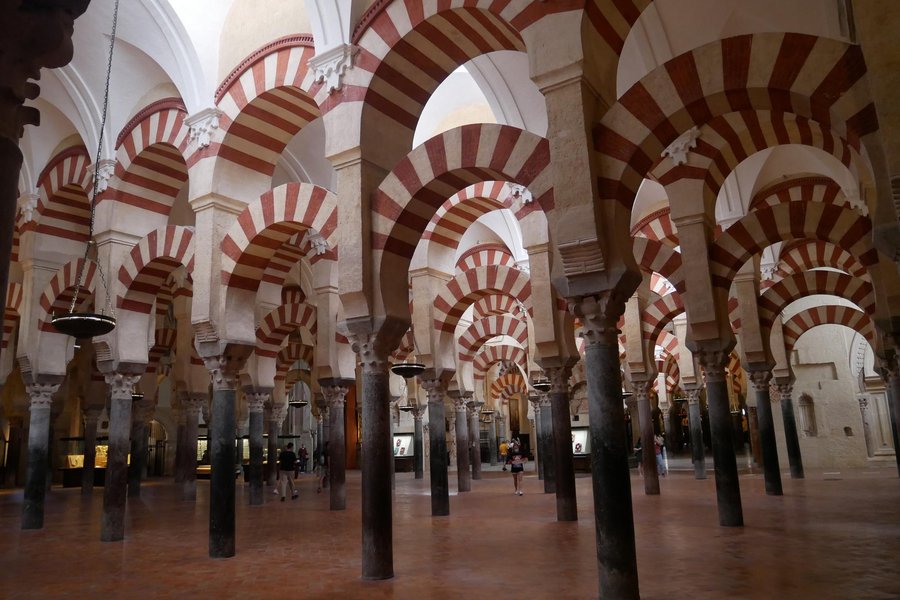
Visited in April 2014. The structure is amazing! The forest of pillars with the double arches reminiscent of the Arabian date palms..you feel like you are walking in a never-ending cool forest. Gives you a feeling of eternity - a hallmark of Muslim art/architecture, where patterns are repeated in seemingly endless ways to give the observer a sense of the eternal life to come after this temporal earthly existence. The sight was a Roman temple, then a church and when the Muslims took over Cordoba they first worshiped side by side with the Christians. Then the need for a mosque was great (as the Muslim population grew) so they bought it from the Church (this is documented...it was not a forceful taking-over) and then constructed this masterpiece. Many caliphs added to it and enlarged it. The Mihrab (prayer niche) is still preserved. Upon the reconquest, the Catholics wanted to tear it down as was every other jamia (main) mosque in every city that was taken over. But the people of Cordoba were so fond of the building they protested. So they built a cathedral in the center. It's a strangely interesting juxtaposition of Christian and Muslim art. A must visit place. You can lose yourself there
Keep reading 0 comments
The Mezquita is one of Spain's (and Europe's) finest tourist attractions, and a fascinating reminder of the period of Arab rule over large parts of Southern Europe. Córdoba at that time was a lot bigger than today, and the capital of a large empire stretching well into North Africa. The Mezquita was the major mosque in the western part of the Muslim domain, and one of the largest anywhere. It includes a very big courtyard and is especially famous for its 856 columns. After the reconquest, it was turned into a cathedral, and during the Renaissance, a nave was built in its centre. Today it is a fascinating mixture of Islamic and Christian architecture. The mihrad (prayer niche) especially is still very well preserved, and there are some remains of the Visigothic church of San Vicente, which preceded the mosque.
The Mezquita was inscribed in 1984, and the site was extended in 1994 to include the entire Historic Centre. This is also quite nice, but nothing really special. There is a Roman bridge (at least the foundations are still Roman), a medieval tower on the other end of the bridge with a somewhat tacky museum, a very small synagogue (one of only three or four remaining in Spain), the Judería district with many historic palaces and townhouses, and, as the city's major sight next to the Mezquita, the Alcázar de los Reyes Cristianos, a major palace with beautiful gardens. It was the royal residence where the reconquest of Granada …
Keep reading 0 comments
I visited the Mezquita and the architecture of the former mosque was amazing. It is also good place to hide hot weather. It was +41 celsius outside but inside the Mezquita was nice and cool. The streets of the old town are narrow and nicely confusing. I wandered there for long time finding beautiful streets.
Keep reading 0 comments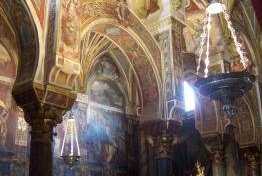
The cathedral in Cordoba was the single most impressive monument I saw on my brief trip around western Andalucía. It is one of the greatest architectural achievements I have visited and really is worthy of the great praise and visitors it receives. The famous horseshoe arches are incredible and you can really get a great feel for the architectural forces of the building.
The much-maligned Christian additions to the mosque were also quite impressive, though under restoration when I visited. It was a major tourist attraction but it was surprising how you can lose tour groups in the forest of pillars, you can also get a pretty decent guided tour by just moving from one group to the next never hearing more than a few phrases from each.
Throughout the historic centre it felt quite hard to get away from areas that were touristy and discover a slightly more authentic side to the city. The centre is very reminiscent of North African medinas, but walking through you would sometimes struggle to find clues that the reconquest has happened as everything sells itself on Moroccan themes. It was very nice but a little false. Though the Banos Arabes (Arab Baths) were a nice treat. Also the food was very good, a recommendation goes to Almatea, which had a great selection of local organic produce and a decent vegetarian menu, which can be hard to come by in this part of Spain. It overlooks the Roman bridge, and I have to agree …
Keep reading 0 comments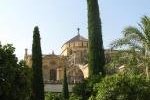
On the way to Seville from Madrid, we stopped by Cordoba for a 3 hour visit. The main sites of the town are the Mosque/Cathedral and the Alcazar. We visited both and I was very impressed with what I saw. The former is not only beautiful but gigantic as well. It is interesting to see the mix of Islamic and Christian designs. Restoration work was taking place both on the interior and exterior and it was crowded but I greatly enjoyed my visit regardless. Best of all, there was no admission fee before ten o'clock. The Alcazar was equally amazing with its ancient baths, towers and beautiful garden. At the time of our visit, the Roman bridge was under restoration and could not be crossed. Personally, I have mixed feelings about the restoration. Looking at old pictures, the bridge looked a lot better unrestored. The restoration has dramatically changed its appearance; it looks like it was built just yesterday nowadays. If it could be done again, I would have stayed a lot longer. Unfortunately, I did not have the chance to visit the Jewish quarter and its synagogue (one of only three ancient ones surviving in Spain, the other 2 being in Toledo). Cordoba was a great introduction to Andalusia and I would enjoy two other WHS (Seville and Alhambra) later on which gave me a positive outlook of the region.
Keep reading 0 comments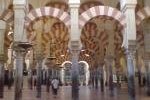
Visited in summer 2007 and must admire this is my most favorite Andalusian site. Before you visit please read some texts about Cordoba, it will help you to understand a bit.
The city has it very own atmosfere which we could feel as we arrived right before sunset. Visiting then the Gardens of Alcazar gives you a great oportunity to feel like an emir :) (on friday night for free). Walking around night in old jewish city through all those narrow street is a great opportunity to breath the city itself.
Next morning we were able to get to Mezquita for free (you have to go there when the mass is happening). This building from outside doesn't look anything special, but once you see all those forrest of pillars you understand. Pillars everywhere are except the site of cathedral built in middle :( Quite unfortunate decision but time approved those two styles can live together.
After this we had delicious Churros on La Plaza de La Corredera - dont miss it - looks similar as Plaza Mayor in Madrid.
For me Cordoba is one of the top sites. Pic: Pillars of Mezquita
Keep reading 0 comments
